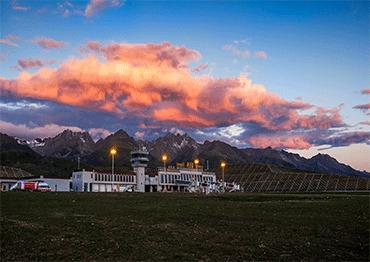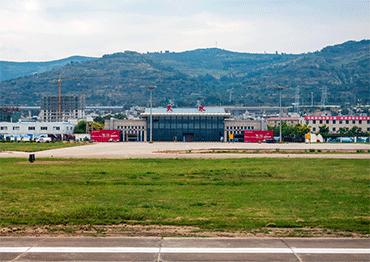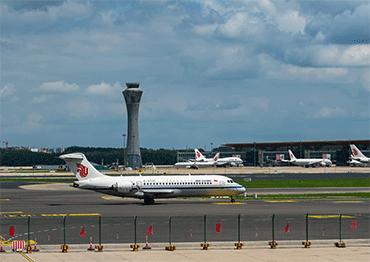Facing high costs and low passenger numbers, Chinese regional airlines
urgently need to reduce their reliance on government support and find market-oriented ways to maintain altitude

A one-day flight test is conducted at Gesar Airport, the third civil regional airport in Ganzi Tibetan Autonomous Prefecture, Sichuan Province, June 13, 2019 (Photo by VCG)
Hotel bookings in rural counties across China grew by 68 percent year-on-year during the May Day holiday (May 1-5), according to Ctrip, a leading Chinese tourism service platform, while ticket sales for local scenic spots shot up by 151 percent, both figures higher than the national average. This increase is partly due to the growth of regional airlines, which offer direct connections to smaller and more remote destinations. The Civil Aviation Administration of China (CAAC) in 2013 defined regional airlines as those that connect to an airport whose annual passenger throughput is below two million and whose single range is no more than 600 kilometers.
Due to smaller passenger numbers and higher operating costs than major airlines that connect big cities, short haul regional airlines, though vital for local transportation, rely on large government subsidies.
In April, Joyair, which operates a regional airline in sparsely-populated western Inner Mongolia Autonomous Region, filed a lawsuit against the government of Alxa, Inner Mongolia for failure to pay subsidies on time as stated in their agreement.
Media reported that Joyair had already suspended flights to Alxa Airport for a long time, but both Joyair and Alxa government refused to speak about the lawsuit.
Many other regional airlines are struggling due to overdue government subsidies.
“In the last two years, many local governments have delayed paying these subsidies to airlines and some now fall into the category of bad [government] debts,” Hang Yi, a civil aviation expert who has worked in the industry for over 20 years, told NewsChina.
“It’s no secret,” he said, indicating that balancing expenditure and revenue is the biggest challenge to developing regional airlines in China.
Little Wings
Regional airlines are crucial for Inner Mongolia’s economy. Stretching 2,400 kilometers from east to west, the region’s 12 cities and counties are spread far apart, so the regional government decided to develop an air network.
Remote areas have to do this to bolster the local economy. Chongqing Qianjiang Wulingshan Airport, in the heart of the scenic Wuling Mountains, is around 200 kilometers by air from urban Chongqing, or 300 kilometers by road, around a four-hour drive east of the metropolis. Built in 2010, the airport has flight connections to regional tourist destinations, as well as Chongqing and other cities in the neighboring provinces of Hubei, Hunan and Guizhou. Annual passenger throughput grew by over 30 percent on average, according to a 2022 report in the Economic Information Daily.
“Transportation brings tourist flows, logistics, capital, information flows and technologies. They keep the metabolism of the economic society as blood vessels do... Transportation is key to high-quality development,” Huang Wei, director of the supervisory board of the Chongqing Airport Group, told the newspaper.
Wu Longjiang, CEO of China Express, a listed private airline company engaged in regional routes, told Carcaijing, a social media account on transportation news under financial magazine Caijing, that he always felt emotional when he saw residents flocking to the airport
for their first glimpse of a passenger jet whenever his company launched a new regional route.
As China’s population is concentrated in the developed and urbanized east and south, experts believe that in the more sparsely populated west, it is more economical to develop regional airlines than highways or high-speed rail. According to Huang Wei, building a four-lane highway generally costs 50 million yuan (US$6.9m) per kilometer and building a high-speed rail line requires 100 million yuan (US$13.8m) per kilometer, while a small regional airport can be built for about 200 million yuan (US$27.7m), though this does not take into account later operating costs.
The CAAC projected that by 2035, China would need 216 more airports, up from 234 civil airports in October 2018 to 450 airports. The CAAC said in February that it expects the annual number of domestic passenger air journeys will reach 1.5 billion by 2035, with 400 million people traveling by plane.
Yet a survey by the Civil Aviation University of China showed that regional flight routes in China accounted for only around 10 percent of total routes, lower than the average level of Europe and the US (30-40 percent). Meanwhile, airports that serve regional airlines contribute just 7 percent of the total passenger capacity to the civil aviation market.
In a 2018 report, the Global Times cited European turboprop plane manufacturer ATR as saying that in the next 20 years, China would need 1,100 more turboprop planes, and by 2037, ATR estimated, 87 percent of China’s flights will come from 2,200 new routes.
Struggling for Takeoff
Despite the huge market potential, regional airlines saw considerable lag in development when compared to China’s major airlines. Data shows that in the past 30 years, flights by China’s major airlines grew by 9.7 percent annually, from 191 in 1986 to 3,615 in 2019. But over the same period, the number of regional flights only increased by 150, with regional jets accounting for around 5 percent of the total passenger aircraft in operation.
At a forum for regional airlines held by the CAAC in 2019, Li Guijin, a professor at the Civil Aviation Management Institute of China, revealed that during the past 18 years of development, regional airlines’ share of the market had decreased from 16 percent to 5 percent, with the number of regional flights at most large airports taking up less than 5 percent. The shares at major air hubs in Beijing, Shanghai and Shenzhen were below 1 percent.
It is much more costly to operate a regional airline than a major one. Different from big planes serving major airlines, mostly Boeings or Airbuses whose purchase price and maintenance costs are low thanks to their large scale, regional airliners are expensive and there are fewer resources for operations and maintenance. Wu Longjiang of China Express told Carcaijing that they often start from scratch to develop regional routes, including training staff, building maintenance facilities and finding parts suppliers.
China’s regional airlines often operate in harsh environments, like mountains, high plateaus and deserts, where they encounter more extreme climates and weather. This requires high safety standards, skilled pilots and quality management, and therefore higher costs.
Profit is harder to come by, however. As the aircraft are smaller and operate in smaller remote markets, passenger load factor (PLF) is smaller too, especially in off-tourist seasons.
According to research by Li Dongsheng, deputy general manager of the marketing and sales department of Tianjin Airlines, Chinese regional airlines’ PLF averages at around 60 percent, so they cannot rely on the market to survive.
There is stiff competition from rail, especially as the high-speed network is expanding so quickly. Regular slow trains are still very cheap for long journeys, and many Chinese people prefer trains for their comfort and safety.
“An airport serving regional airlines won’t be stable economically until its annual passenger throughput hits three million,” Li Lingxiang, business president of regional airline LoongAir, told NewsChina.
In April 2016, LoongAir opened a route from Hangzhou, capital of Zhejiang Province to Enshi in western Hubei Province, only to find that the company lost a total of 60 million yuan (US$8.3m) within six months. Officials from Enshi, who were eager to retain the only flight between the two regions, went to talk with LoongAir, promising hefty support from the governments of both Hangzhou and Enshi. Now the route is operating well.
“We spent over two years promoting this first flight between Hangzhou and Enshi... and then we started more flights to Enshi and gradually transferred the government subsidies from old routes to new ones,” Li said.

Maijishan Airport, Tianshui, Gansu Province, August 18, 2019. The small provinical city became famous in early 2024 when visitors flocked there for its local version of a spicy soup called malatang (Photo by VCG)

A China-made ARJ21, a regional aircraft operated by Air China, Beijing, July 3, 2021 (Photo by VCG)
Financial Lift
In summer 2023, LoongAir brought separate lawsuits against local governments in Qinhuangdao, Hebei Province and Yulin in Guangxi Zhuang Autonomous Region, as well as a State-owned enterprise, Wenshan Aviation Service in Yunnan Province, for delays to subsidy payments. A manager at LoongAir who refused to reveal his name told NewsChina that one of the local governments has paid in full and they are still negotiating with the other two entities about payments by installment.
The situation is common for regional airline companies which survive on government subsidies and providing airline tickets for official use. CAAC data from 2023 shows that more than half of regional airlines have not returned to their pre-pandemic condition.
China Express has posted huge losses since 2021. Although the amount of losses has narrowed, they still suffered a net loss of 965 million yuan (US$133.5m) in 2023. The company’s fiscal reports show their government subsidies fell from 638 million yuan (US$88.3m) in 2020 to 140 million yuan (US$19.4m) in 2023. In the past four years, China Express has sold or leased out their aircraft twice to keep solvent.
“One provincial government owes us 100 million yuan (US$13.8m) in subsidies,” a manager of another regional airline company told NewsChina on condition of anonymity. He revealed that it is a province in southwestern China which is also a focus of poverty alleviation campaigns. Although the increasingly large overdue payment is jeopardizing the company, they do not want to complicate the problem as they cooperate with the local government very well in other areas.
“Some local governments have owed us money for one to two years,” Li Dongsheng told NewsChina, although he would not say which government or how much. “For the sake of future cooperation and development, most airline companies would rather solve the problem by negotiation,” he said.
Although major domestic and international airlines also receive some government subsidies, Cui Xinyu, the deputy marketing president of Qingdao Airlines based in Shandong Province, said that regional airlines can only get going in the first place if they have government financial support, and this must continue until there are consistent passenger numbers.
In 2020, airline China Express had a net profit of 613 million yuan (US$84.9). The same year, they received 638 million yuan (US$88.4m) in government subsidies.
“Government subsidies are the key revenue source to maintaining new regional routes,” Cui told NewsChina.
Non-financial Metrics
Governments do not consider regional airlines as purely commercial, so they do not measure performance just by financial metrics.
As early as 2012 at a press conference on regional airline losses, Huang Min, an official from the National Development and Reform Commission, said that measuring a regional airline has to take into account its contributions to local economies and society, including tourism and emergency rescue facilitation. He added that regional airlines also feed more passengers into larger airports, increasing their efficiency and passenger flow.
Over the past decade, the government has reviewed regional airline subsidies several times in favor of regional jets, regional airports and services to remote areas.
However, as local governments are tightening their belts due to the post-pandemic economic slowdown, regional airlines have to find other ways to support themselves.
One way is reducing short-haul intraregional routes on small aircraft. Airline companies are purchasing larger planes which are more economical and can fly to larger hubs. In 2018, China Express introduced Airbus 320 aircraft. Tianjin Airlines spent eight years developing from a regional airline to operating major domestic and international routes.
According to Li Lingxiang, the regional routes LoongAir operated accounted for more than 50 percent of the company’s total at the beginning. Now, although they operate the same number of regional flights, the ratio is falling as the airline has expanded the number of flights to major cities and hubs.
“It’s because major airlines make more profits,” Lin Zhijie, an expert from the Aviation Think Tank, told NewsChina. He said that based on his own calculations, regional airline profits were about half that of big airlines that operate a hub flight network. Furthermore, profitless regional flights are used as a way into the market by new entrants, who do not mind taking a loss initially if they can use it as way to eventually get a foothold on the very profitable inter-city air routes, Lin said.
According to Cui Xinyu, governments of small cities desire most a connection to a big city like Beijing and Shanghai as they feel it will be the quickest way to increase passenger flow and stimulate the local economy.
But this is not a guaranteed solution, as flight schedules at major airport hubs are dominated by major airlines, and busy airports are reluctant to cooperate with regional airlines due to low passenger numbers.
That requires regional airlines to tailor the market to a region’s specific conditions. An effective way is to link a regional airport to shuttle to a nearby main hub.
China Express used a regional jet of under 90 seats to increase the number of the flights between Xingyi, a tourism destination in southwest Guizhou Province, to provincial capital Guiyang, to eight each day, managing to increase the passenger transfer rate at Xingyi Wanfenglin Airport by over 30 percent and annual passenger throughput by over 56 percent. The two cities do not have a direct train connection.
By 2019, Xingyi’s aviation network covered 101 cities, 20 times that of 2014, with passenger throughput increasing from 174,000 to 1.39 million, an annual compound growth of 51.4 percent, higher than the national level of 41.2 percent.
After the small city of Tianshui in western Gansu Province shot to fame in March for its malatang, a type of spicy soup, tourists flocked to the remote destination for the delicacy. China Express operated the only daily flight from Tianshui, a route connecting the major cities of Chongqing and Tianjin with a stopover at Tianshui Maijishan Airport. The flight’s PLF rose to 85 percent, boosting tourism in Tianshui, as well as increasing the number of passengers into Chongqing and Tianjin.
“For regional airline companies, the popularity of Tianshui doesn’t do much to help regional airlines predict which city will be the next hot destination, but it will promote them to find a potential region and then increase its connectivity by linking it to bigger airports and hub airports,” the anonymous manager whose company operates a regional route in a southwestern province told NewsChina.
CAAC official Yu Biao told the Economic Daily in 2021 there is usually not much demand for flights connecting two regional airports and developing them takes a long time. He suggested regional airlines first connect to hubs or big airports and when the market becomes stable, it will be easier to operate regional routes to smaller destinations.
“Regional airlines will only survive when they launch and develop new routes based on market rules and passenger demand, plus proper government subsidies and guidance,” Cui Xinyu told NewsChina.

 Old Version
Old Version


